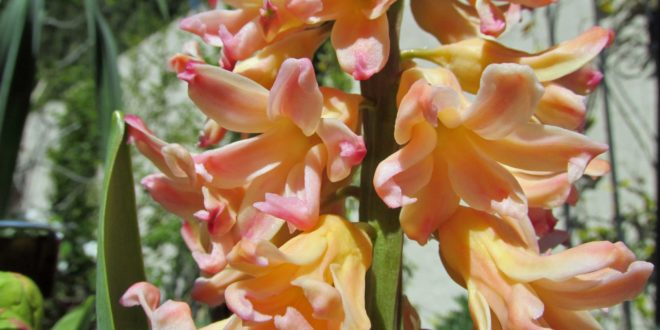We grow hyacinth in our Sunnyvale garden most years. Attractive to bees, butterflies and/or birds. Flowers are fragrant. This plant is suitable for growing indoors. The Dutch Hyacinth does best if planted new every year. Hyacinth blooms the first week in March, after the crocus have finished blooming, and right before the tulips start blooming.
In 2019 we planted Deep Pink. In 2017 we went with Apricot Sunset —
Muscari aka grape hyacinth, is a different genus than the Dutch hyacinth. Muscari naturalizes and comes up every year.
Dutch Hyacinth, Hyacinthus orientalis. Hyacinthus is a small genus of bulbous, fragrant flowering plants in the family Asparagaceae, subfamily Scilloideae. These are commonly called hyacinths. The genus is native to the eastern Mediterranean (from the south of Turkey through to northern Israel). Average Water Needs; Water regularly; do not overwater. Flowers are good for cutting.
Severe poisoning from hyacinth or tulip poisoning is often seen when dogs dig up freshly planted bulbs or having access to a large bag of them. When the plant parts or bulbs are chewed or ingested, it can result in tissue irritation to the mouth and esophagus.
Family: Hyacinthaceae
Genus: Hyacinthus (hy-uh-SIN-thus) (Info)
Species: orientalis (or-ee-en-TAY-liss) (Info)
Cultivar: ?
Category: Bulbs
Height: 6-12 in. (15-30 cm)
Spacing: 6-9 in. (15-22 cm)
Hardiness:
USDA Zone 3b: to -37.2 °C (-35 °F)
USDA Zone 4a: to -34.4 °C (-30 °F)
USDA Zone 4b: to -31.6 °C (-25 °F)
USDA Zone 5a: to -28.8 °C (-20 °F)
USDA Zone 5b: to -26.1 °C (-15 °F)
USDA Zone 6a: to -23.3 °C (-10 °F)
USDA Zone 6b: to -20.5 °C (-5 °F)
USDA Zone 7a: to -17.7 °C (0 °F)
USDA Zone 7b: to -14.9 °C (5 °F)
USDA Zone 8a: to -12.2 °C (10 °F)
USDA Zone 8b: to -9.4 °C (15 °F)
USDA Zone 9a: to -6.6 °C (20 °F)
USDA Zone 9b: to -3.8 °C (25 °F)
Sun Exposure: Full Sun, Sun to Partial Shade
Danger: Parts of plant are poisonous if ingested
Bloom Color: Blue-Violet
Bloom Time: Late Winter/Early Spring
Foliage: Herbaceous
Soil pH requirements: 6.1 to 6.5 (mildly acidic), 6.6 to 7.5 (neutral), 7.6 to 7.8 (mildly alkaline)
Patent Information: Unknown – Tell us
Propagation Methods: By dividing rhizomes, tubers, corms or bulbs (including offsets)
Seed Collecting: N/A: plant does not set seed, flowers are sterile, or plants will not come true from seed
Read more: http://davesgarden.com/guides/pf/go/55569/#ixzz3Hk32g4EO








